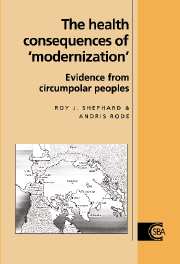Book contents
- Frontmatter
- Contents
- Preface
- 1 The circumpolar habitat and its peoples: traditional lifestyle and early research findings
- 2 Concept of the International Biological Programme Human Adaptability Project, and IBP studies of circumpolar populations
- 3 Changes in social structure and behaviour
- 4 Secular trends in diet, metabolism and body composition
- 5 Secular trends in physical fitness and cold tolerance
- 6 Secular trends in respiratory hazards, lung function and respiratory disease
- 7 Secular trends in growth and development
- 8 Current health status of circumpolar populations
- 9 Postscript: lessons from traditional circumpolar life and options for the future
- References
- Index
5 - Secular trends in physical fitness and cold tolerance
Published online by Cambridge University Press: 05 March 2012
- Frontmatter
- Contents
- Preface
- 1 The circumpolar habitat and its peoples: traditional lifestyle and early research findings
- 2 Concept of the International Biological Programme Human Adaptability Project, and IBP studies of circumpolar populations
- 3 Changes in social structure and behaviour
- 4 Secular trends in diet, metabolism and body composition
- 5 Secular trends in physical fitness and cold tolerance
- 6 Secular trends in respiratory hazards, lung function and respiratory disease
- 7 Secular trends in growth and development
- 8 Current health status of circumpolar populations
- 9 Postscript: lessons from traditional circumpolar life and options for the future
- References
- Index
Summary
This chapter begins by describing certain features of fitness patterns that were observed among indigenous circumpolar residents at the time of the IBP-HAP surveys, particularly seasonal effects and inter- and intra-community differences related to the early phases of acculturation to a sedentary, urban lifestyle. Information on secular trends in aerobic power, anaerobic power and capacity, lean tissue mass and muscle strength is then drawn from communities where cross-sectional surveys have been repeated or longitudinal analyses undertaken. Changes in cold tolerance are considered in similar fashion, and finally the possibility of developing community programmes to conserve physical fitness is explored in the context of indigenous societies.
Lifestyle, season and fitness: the IBP-HAP findings
Fitness levels
Early information on the physical fitness of circumpolar populations, obtained mainly by non-standard methodology, was summarized in Chapter 1. Despite limitations in the available data, the conclusion was drawn that in the 1950s and 1960s, the small samples of people that were tested had a higher fitness level than would have been expected in sedentary city dwellers of similar age. However, it was unclear whether those examined were representative of their communities, and it was also uncertain how much the individual fitness levels may have been biased downward by such factors as malnutrition and the ravages of chronic disease, particularly tuberculosis (Andersen & Hart, 1963).
Aerobic power
The IBP-HAP data on aerobic power is summarized in Table 5.1 and Fig. 5.1. At most of the circumpolar test sites, direct measurements of maximal oxygen intake were only obtained on small samples of subjects, with younger adults preponderating.
- Type
- Chapter
- Information
- The Health Consequences of 'Modernisation'Evidence from Circumpolar Peoples, pp. 123 - 150Publisher: Cambridge University PressPrint publication year: 1996

